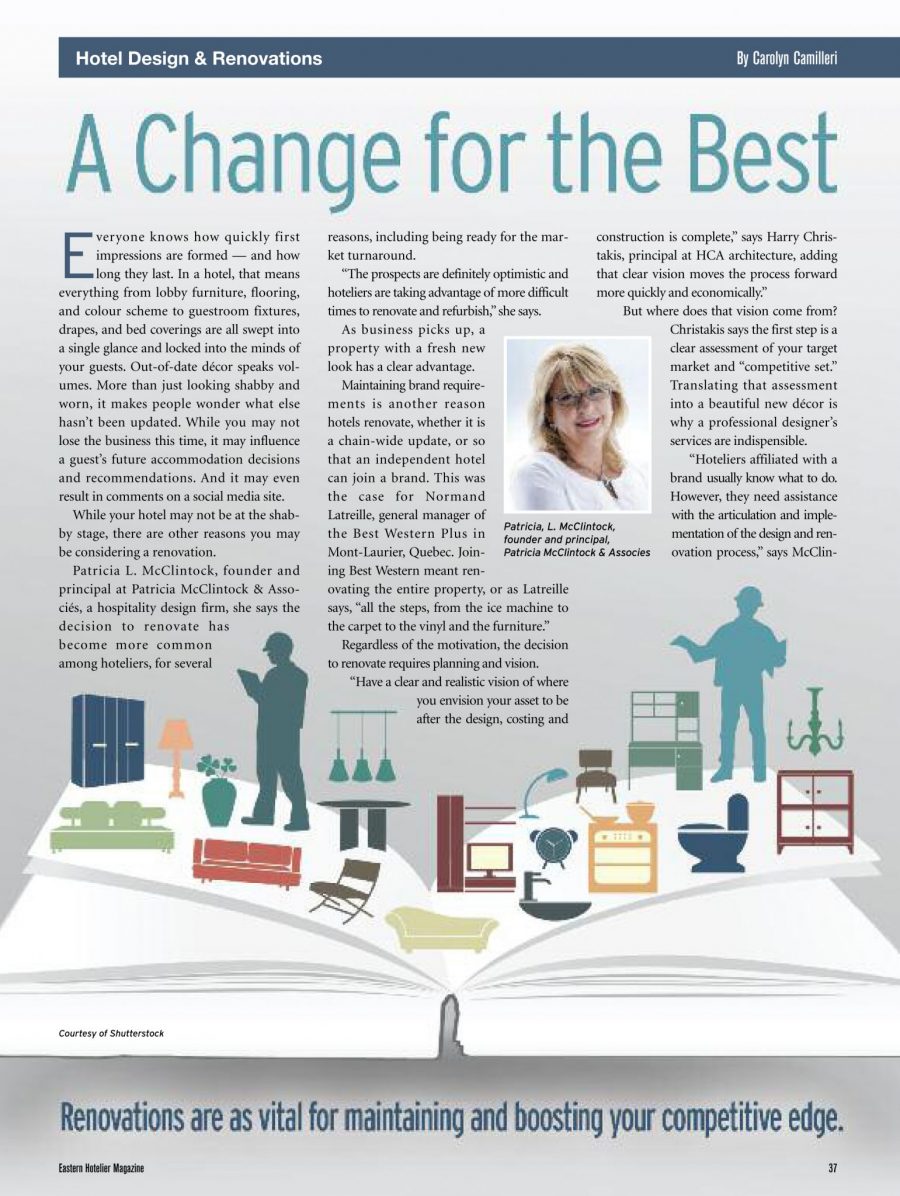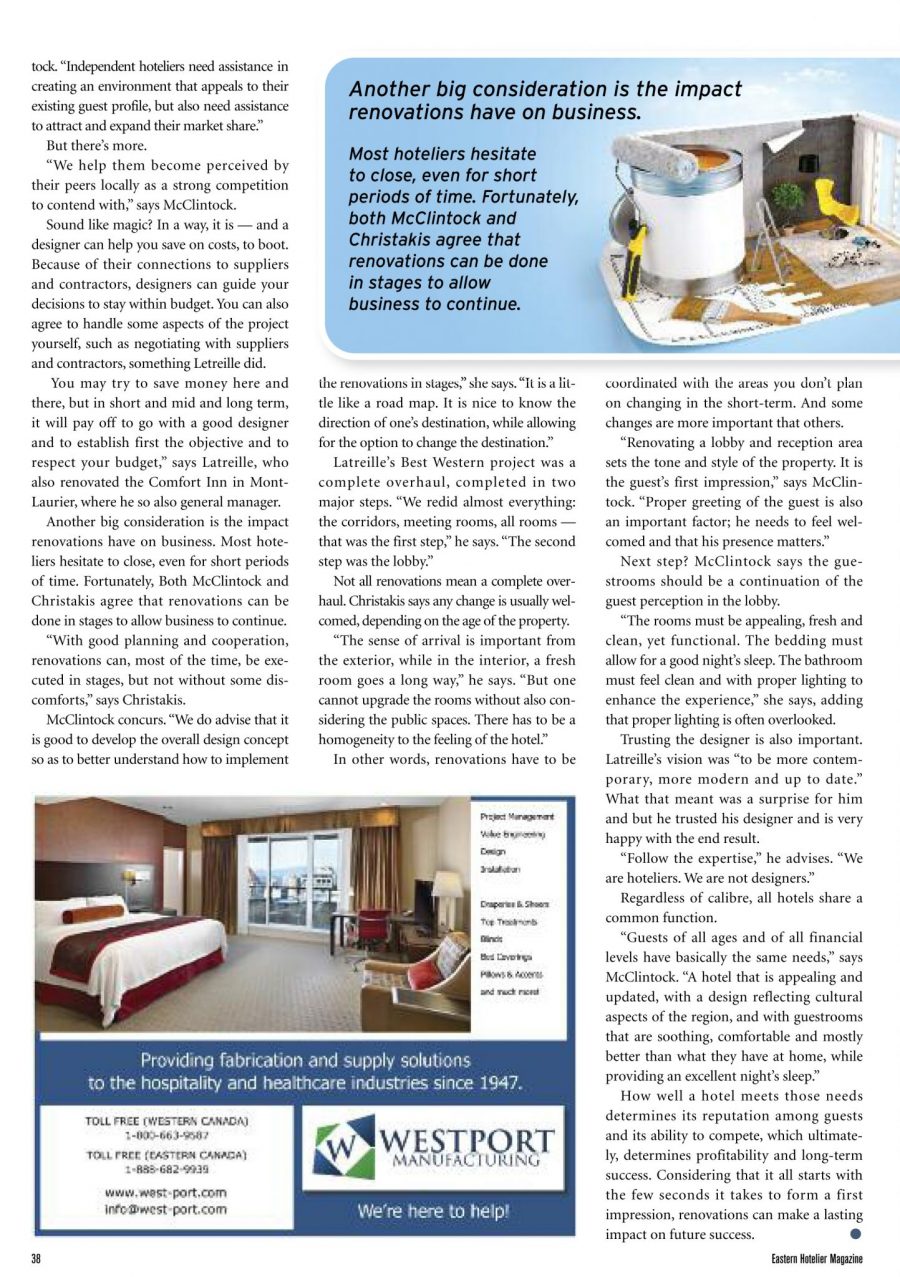
A Change for the Best
Hotel Design & Renovations – By Carolyn Camillery
Everyone knows how quickly first impressions are formed – and how long they last. In a hotel, that means everything from lobby furniture, flooring, and colour scheme to guestroom fixtures, drapes, and bed coverings are all swept into a single glance and locked into the minds of your guests. Out-of-date decor speaks volumes. More than just looking shabby and worn, it makes people wonder what else hasn’t been updated. While you may not lose the business this time, it may influence a guest’s future accommodation decisions and recommendations. And it may even result in comments on a social media site.
While your hotel may not be at the shabby stage, there are other reasons you may be considering a renovation.
Patricia L. McClintock, founder and principal at Patricia McClintock & Associés, a hospitality design firm, she says the decision to renovate has become more common among hoteliers, for several reasons, including being ready for the market turnaround.
« The prospects are definitely optimistic and hoteliers are taking advantage of more difficult times to renovate and refurbish,” she says.
As business picks up, a property with a fresh new look has a clear advantage.
Maintaining brand requirements is another reason hotels renovate, whether it is a chain-wide update, or so that an independent hotel can join a brand. This was the case for Normand Latreille, general manager of the Best Western Plus in Mont-Laurier, Quebec. Joining Best Western meant renovating the entire property, or as Latreille says, « all the steps, from the ice machine to the carpet to the vinyl and the furniture.”
Regardless of the motivation, the decision to renovate requires planning and vision.
« Have a clear and realistic vision of where you envision your asset to be after the design, costing and construction is complete,” says Harry Christakis, principal at HCA architecture, adding that clear vision moves the process forward more quickly and economically.
But where does that vision come from? Christakis says the first step is a clear assessment of your target market and « competitive set.” Translating that assessment into a beautiful new decor is why a professional designer’s services are indispensable.
« Hoteliers affiliated with a brand usually know what to do. However, they need assistance with the articulation and implementation of the design and renovation process,” says McClintock.
Renovations are as vital for maintaining and boosting your competitive edge.
« Independent hoteliers need assistance in creating an environment that appeals to their existing guest profile, but also need assistance to attract and expand their market share. »
But there’s more.
« We help them become perceived by their peers locally as a strong competition to contend with,” says McClintock.
Sound like magic? In a way, it is – and a designer can help you save on costs, to boot. Because of their connections to suppliers and contractors, designers can guide your decisions to stay within budget. You can also agree to handle some aspects of the project yourself, such as negotiating with suppliers and contractors, something Letreille did.
You may try to save money here and there, but in short and mid and long term, it will payoff to go with a good designer and to establish first the objective and to respect your budget, » says Latreille, who also renovated the Comfort Inn in Mont Laurier, where he is also general manager.
Another big consideration is the impact renovations have on business. Most hoteliers hesitate to close, even for short periods of time. Fortunately, both McClintock and Christakis agree that renovations can be done in stages to allow business to continue.
« With good planning and cooperation, renovations can, most of the time, be executed in stages, but not without some discomforts,” says Christakis.
McClintock concurs. « We do advise that it is good to develop the overall design concept so as to better understand how to implement the renovations in stages,” she says. « It is a little like a road map. It is nice to know the direction of one’s destination, while allowing for the option to change the destination.”
Latreille’s Best Western project was a complete overhaul, completed in two major steps. « We redid almost everything: the corridors, meeting rooms, all rooms – that was the first step,” he says. « The second step was the lobby.”
Not all renovations mean a complete overhaul. Christakis says any change is usually welcomed, depending on the age of the property.
« The sense of arrival is important from the exterior, while in the interior, a fresh room goes a long way,” he says. « But one cannot upgrade the rooms without also considering the public spaces. There has to be homogeneity to the feeling of the hotel.”
In other words, renovations have to be coordinated with the areas you don’t plan on changing in the short-term. And some changes are more important than others.
« Renovating a lobby and reception area sets the tone and style of the property. It is the guest’s first impression,” says McClintock. « Proper greeting of the guest is also an important factor; he needs to feel welcomed and that his presence matters. »
Next step? McClintock says the guestrooms should be a continuation of the guest perception in the lobby.
« The rooms must be appealing, fresh and clean, yet functional. The bedding must allow for a good night’s sleep. The bathroom must feel clean and with proper lighting to enhance the experience,” she says, adding that proper lighting is often overlooked.
Trusting the designer is also important. Latreille’s vision was « to be more contemporary, more modern and up to date. » What that meant was a surprise for him and but he trusted his designer and is very happy with the end result.
« Follow the expertise,” he advises. « We are hoteliers. We are not designers.”
Regardless of caliber, all hotels share a common function.
« Guests of all ages and of all financial levels have basically the same needs,” says McClintock. « A hotel that is appealing and updated, with a design reflecting cultural aspects of the region, and with guestrooms that are soothing, comfortable and mostly better than what they have at home, while providing an excellent night’s sleep.”
How well a hotel meets those needs determines its reputation among guests and its ability to compete, which ultimately, determines profitability and long-term success. Considering that it all starts with the few seconds it takes to form a first impression, renovations can make a lasting impact on future success.
Eastern Hotelier Magazine


